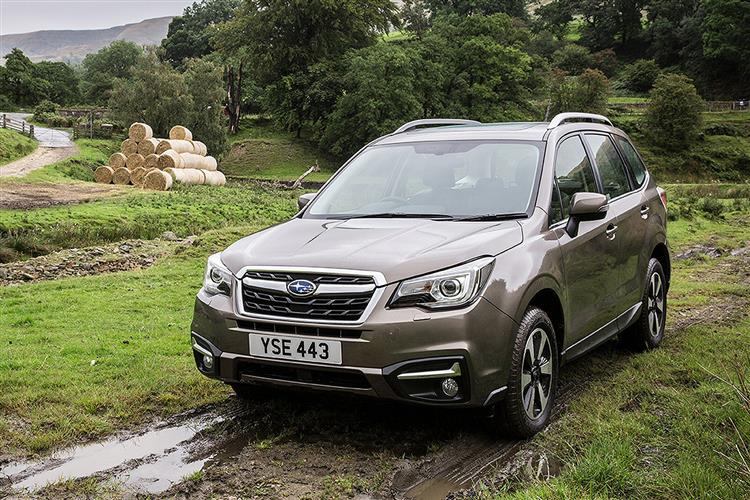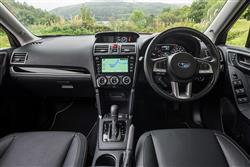How will you view?
This is a sample, and will stop after 30 seconds.
MORE QUESTIONS OF FORESTRY (some text hidden) SECTIONED_new_subaruforester_2016
By Jonathan Crouch
Introductionword count: 173
Wouldn't it be nice to find a properly capable compact SUV? A car that could walk the walk as well as talking the talk? A car like this one, Subaru's fourth generation 'SJ'-series Forester. It was launched in 2013, then updated in 2015 but the version we're looking at here as a potential used car buy is the last version of this design, which sold between 2017 and 2019 and offered buyers the option of Lineartronic auto transmission with the diesel engine that most of them wanted. Everything about this design seems to be nicely balanced, from the shape and positioning of its unique 'Boxer' engines to the shape and positioning of its intended clientele. People who want something fashionable, but don't need to make a fashion statement. People who want something tough and rugged, but don't need to tackle the Rubicon Trail. So the smarter styling inside and out will go down as well as the Symmetrical All-Wheel-Drive system and the X-Mode off road technology. It's all been very carefully thought out.
Modelsword count: 13
5dr SUV (2.0 petrol. 2.0 diesel [X, XE, XE Premium, XC, XC Premium])
Historyword count: 414
Some cars command almost unquestioning customer loyalty - and this is one of them, Subaru's Forester. It's a car with a blend of qualities that loyal buyers will tell you they can't really find replicated in quite the same way anywhere else. So, just as there are performance sportscars but only one Porsche 911 and there are luxury SUVs but only one Range Rover, so this car commands a small but unique position as an all-wheel drive stepping stone between 4x4 estate and ownership of a fully-fledged upper-mid-sized SUV. But hold on, isn't that simply a definition for what the modernday market defines as a 'D'-segment 'Crossover', cars like Volkswagen's Tiguan or Toyota's RAV4? Well no not really. All of these kinds of models bring with them the faint feel of style over substance. Nothing wrong with that of course, if it's what you want. Subaru even satisfies these people with their neatly packaged XV model. But it isn't really Foresting territory. You buy this car for what it does, not for what it says about you. Talk to almost any Forester owner and they'll tell you of times when they cruised past other similar vehicles that came unstuck when the going got tough. They'll tell you that nothing ever fell off. That nothing ever went wrong. And that nothing would persuade them to buy anything else. Which would be great for Subaru's UK importers if there were a lot of these kinds of people. But there aren't. Since the original launch of this model way back in 1997, it's remained a small niche choice amongst rural buyers who often still think of it as the kind of car it was in its first two generations of life - a kind of rough road estate. That appeal was subtly tweaked in third generation form to create something more Freelander or RAV4-like, an approach that was further refined by this MK4 model, a car launched here in the Summer of 2012 with more space and technology, plus a wider range of engines, then updated in early 2015 with a Lineartronic auto gearbox option for the petrol engine, plus more efficient emissions and a higher quality interior. For the 2017 model year, the Lineartronic auto option was extended to diesel buyers and in this form, the car saw out its production run until it was replaced by an all-new 'SK'-series e-Boxer model in late 2019. It's these last 2017-2019-era 'SJ'-series Forester models we look at here.
What You Getword count: 412
The key change made to this improved MK4 model occurred in 2015 with the addition of a factory-fit touchscreen infotainment and navigation system. The 7.0-inch touchscreen allows front seat occupants to control the Forester's satellite navigation and audio systems using the same touchscreen functionality as a smartphone, with swiping and pinching-in and -out to zoom in on map displays. Drivers can control the infotainment and navigation system - as well as the climate control - with Subaru's latest-generation voice control system, while full Bluetooth functionality enables users to connect their smartphone to the car via StarLink, for weather and traffic reports, wireless audio and news updates. Otherwise, in the course of this model's production run, the recipe wasn't much changed over that of the original version of this fourth generation car. It's a fairly good looking thing but it's no head turner. The interior progressed in leaps and bounds throughout this 'SJ'-series model's life though, with Subaru wisely investing in the 'touch points' such as the steering wheel, handbrake and gear shift, while optimising the switchgear feel of all other controls. Those of you who remember Subaru interiors feeling about as plush as a Photo-Me booth will appreciate the use of higher grade materials on the dashboard, the centre console and doors. There's certainly plenty of room in the cabin than you might expect. Whereas earlier Forester models had found themselves to be out-classed by cars like the Toyota RAV4, the Honda CR-V, the Land Rover Freelander and the Nissan X-TRAIL when it came to interior packaging, this MK4 model was able to compete on far more equal terms with small SUVs of this kind when it came to cabin quality. It certainly feels spacious compared to the pre-2012 MK3 model, thanks to a 23mm increase in rear legroom and the designers' decision to move the base of the A-pillar 200mm forward, improving visibility and creating a sense of spaciousness for front seat occupants. The overall width of the cabin grew too for MK4 model buyers, up 20mm to 1,540mm, increasing the distance between the driver and front passenger seat to bring about best-in-class shoulder room and elbow space. And with this fourth generation version, buyers got 12% more boot space, total capacity up from 450 to 505-litres. When the rear seats are folded down, boot space increases to 1,592-litres, giving an immensely usable area. Original buyers also got the option of a powered tailgate - though it's painfully slow to operate.
To see the full road test text contact us on 0330 0020 227
Pictures (high res disabled)

.jpg)
|
.jpg)
|
.jpg)
| |||
.jpg)
|
.jpg)
|
.jpg)
| |||
.jpg)
|
.jpg)
|
.jpg)
| |||
.jpg)
|

|
Scoring (subset of scores)
Category: Crossover or SUV 4x4s
| Performance | |
| Handling | |
| Comfort | |
| Space | |
| Styling, Build, Value, Equipment, Depreciation, Handling, Insurance and Total scores are available with our full data feed. | |



